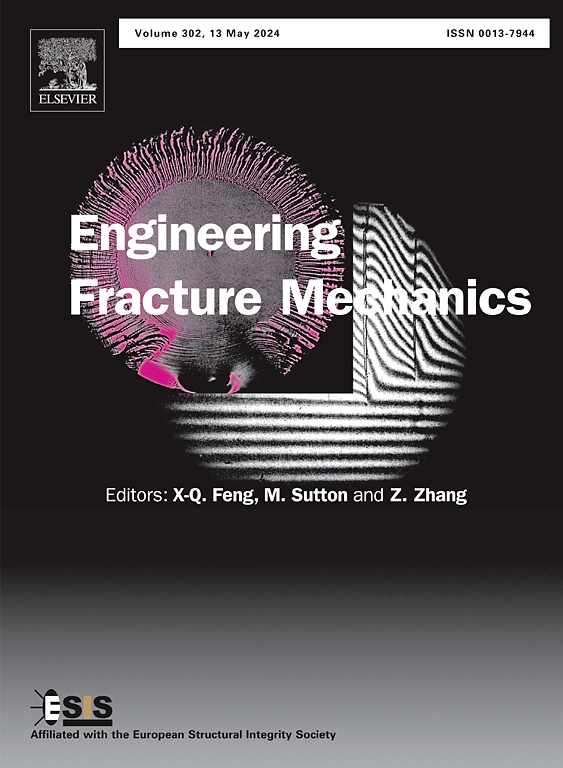Fracture pattern and failure mechanism of sandstone impacted by a high-pressure water jet under different stress loading states
IF 4.7
2区 工程技术
Q1 MECHANICS
引用次数: 0
Abstract
High-pressure water jet technology is widely recognized as an efficient method for rock fragmentation in underground energy development and tunnel excavation engineering. The stress conditions of rock significantly influence the characteristics and efficiency of water jet breaking rock breakage. This study combines experimental and numerical simulation approaches to investigate the fracture patterns and failure mechanisms of rock subjected to water jet impact under various stress loading states. Through rock-breaking experiments, the effects of stress loading state, jet pressure, and rock lithology on the fragmentation characteristics and efficiency of sandstone were systematically examined. Utilizing a smoothed particle hydrodynamics-finite element method coupled algorithm, the evolution laws of damage and stress within the rock were quantitatively analyzed by introducing the comprehensive destructive-damage factor (Fcdd). Furthermore, the mechanisms underlying different fracture patterns and characteristics of sandstone fragmentation under varying stress loading states were elucidated. The results demonstrate that as stress loading increases, the threshold pressure for rock fragmentation rises, while rock-breaking efficiency decreases. Both rock-breaking depth and volume exhibit distinct trends with increasing jet pressure, following an S-shaped and exponential relationship, respectively. The unilateral stress loading is beneficial for the rock fragmentation and damage, with a more serious damage in stress loading direction, which is conducive to splitting fracture. Under the combined influence of jet impact and two-dimensional stress loading, the rock-breaking volume decreases, whereas the Fcdd value increases within a certain range. Three-dimensional stress loading significantly reduces the extent of rock fragmentation and damage, with both rock-breaking volume and Fcdd value decreasing exponentially as stress loading increases. Surface rock elements undergo instantaneous brittle failure, while deeper elements experience cumulative plastic damage. Stress loading has minimal impact on surface rock due to the extremely high water-hammer pressure but prolongs the initiation and accumulation of rock damage. Under water jet impact, the rock sequentially forms an erosion hole, fracture zone, plastic damage zone, elastic zone, and undamaged zone. Fragmentation and damage are more severe in the direction of greater stress loading, resulting in a larger fragmentation range. These findings could provide valuable insights for optimizing high-pressure water jet technology to efficiently break loaded rock in stress-endowed environments.
不同应力加载状态下高压水射流冲击砂岩的破裂模式及破坏机制
高压水射流技术是地下能源开发和隧道开挖工程中公认的一种高效破岩方法。岩石的应力条件对水射流破岩特性和破岩效率有显著影响。本文采用实验和数值模拟相结合的方法,研究了不同应力加载状态下岩石在水射流作用下的破裂形态和破坏机制。通过破岩实验,系统考察了应力加载状态、射流压力和岩石岩性对砂岩破碎特性和效率的影响。采用光滑颗粒流体力学-有限元耦合算法,引入综合破坏损伤因子(Fcdd),定量分析了岩石内部损伤和应力的演化规律。此外,还分析了不同应力加载状态下不同裂缝形态的形成机理和砂岩破碎特征。结果表明:随着应力载荷的增大,破岩阈值压力增大,破岩效率降低;随着射流压力的增加,破岩深度和破岩体积均呈现明显的s型和指数关系。单向应力加载有利于岩石破碎损伤,应力加载方向损伤更严重,有利于劈裂破裂。射流冲击和二维应力载荷共同作用下,破岩体积减小,fdd值在一定范围内增大。三维应力加载显著降低岩石破碎破坏程度,岩石破碎体积和fdd值随应力加载的增加呈指数减小。表层岩石单元经历瞬时脆性破坏,深层岩石单元经历累积塑性破坏。由于水锤压力极高,应力加载对地表岩石的影响很小,但却延长了岩石损伤的发生和积累时间。在水射流作用下,岩石依次形成侵蚀孔、破裂区、塑性损伤区、弹性区和未损伤区。应力载荷越大,破碎破坏越严重,破碎范围越大。这些发现可以为优化高压水射流技术提供有价值的见解,以有效地破坏应力环境中的负载岩石。
本文章由计算机程序翻译,如有差异,请以英文原文为准。
求助全文
约1分钟内获得全文
求助全文
来源期刊
CiteScore
8.70
自引率
13.00%
发文量
606
审稿时长
74 days
期刊介绍:
EFM covers a broad range of topics in fracture mechanics to be of interest and use to both researchers and practitioners. Contributions are welcome which address the fracture behavior of conventional engineering material systems as well as newly emerging material systems. Contributions on developments in the areas of mechanics and materials science strongly related to fracture mechanics are also welcome. Papers on fatigue are welcome if they treat the fatigue process using the methods of fracture mechanics.

 求助内容:
求助内容: 应助结果提醒方式:
应助结果提醒方式:


